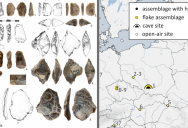500,000-Year-Old Tools May Have Belonged To A Species Of Extinct Hominid
The tools, found in a Polish cave, seem to suggest that early humans made their way into central Europe earlier than anyone had previously thought.
Experts believe the tools were likely fashioned by Homo heidelbergensis, the last common ancestor of Neanderthals and modern humans.
“Peopling of Central Europe by Middle Pleistocene hominids is highly debatable, mainly due to the relatively harsh climatic and environmental conditions that require cultural and anatomical adjustments.”

Image Credit: Nature
One of the biggest reasons that evidence for or against is scarce is because crossing the range would have been extremely difficult.
The cave, known as the Tunel Wielki cave, is located just north of Krakow. It also contains the remains of ancient animals that were alive between 450,000-500,000 years ago.
Among the bones were those of several large, extinct carnivores like Lycaon lycaonoides, which is a large species of wild dog.

Image Credit: Nature
The 40 flint artifacts found within the same layer of sediment suggest they were made by H. heidelbergensis – the first to be found within a cave as opposed to out in the open air.
“We were surprised that half a million years ago people in this area stayed in caves, because those were not the best places to camp. Moisture and low temperature would discourage that. On the other hand, a cave is a natural shelter. It is a closed space that gives a sense of security. We found traces that may indicate that the people who stayed there used fire, which probably helped tame these dark and moist places.”
The researchers did say that Tunel Wielki was likely as far north into the Carpathains as people could have gone at the time.

Image Credit: Nature
“It is rather unlikely that they went farther north. We are probably on the northern limit of their survival.”
Research continues, as the scientists there hope to find H. heidelbergensis bones that will corroborate their current findings.

Sign up to get our BEST stories of the week straight to your inbox.




